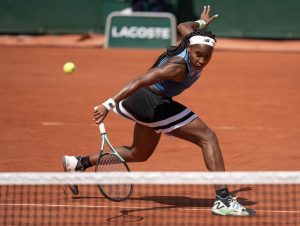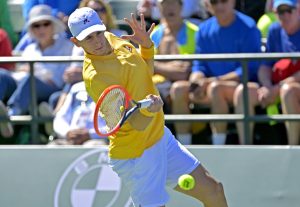For the members of Great Britain’s Davis Cup team, the clay court season will begin a week earlier than for most male players, as they face the unenviable task of trying to beat France on clay at Rouen this weekend. Even though France have lost most of their first (and even second) choice players, as Gael Monfils, Richard Gasquet, and Gilles Simon have all been ruled out through injury, they can still boast one of last season’s breakthrough players, Lucas Pouille, and a wily and skillful veteran in Jeremy Chardy. Moreover, even though Pouille and Chardy may lack the star quality of their more famous compatriots, they will undoubtedly have one considerable advantage over Britain’s singles players, who in the absence of the injured World No. 1 Andy Murray will be Kyle Edmund and Dan Evans. As Britain’s Davis Cup Captain, Leon Smith, put it this week, “The French players are obviously more attuned to clay having been brought up on it”. In the case of Evans in particular, that advantage will be even more pronounced, in that he has never played a clay court tournament on the main ATP tour and his experience of playing on “the red stuff” is limited to second-tier Futures and Challenger tournaments.
In a way, this divide between British inexperience of clay court tennis and French familiarity with it symbolises probably the greatest divide in world tennis, between the Anglophone (American, Australian, and British) tennis world, whose players have generally done better on faster grass or hard court surfaces, and the Francophone/Spanish/European tennis world, where clay is by far the most common surface and grass, a much faster but also much slipperier and more treacherous surface, is regarded with the suspicion that Anglophone players have traditionally regarded clay. Even some of the greatest tennis players ever, such as Pete Sampras and John McEnroe, failed to master the “terre battue,” as clay is traditionally called in France, instead feeling that it was a terrible battle to play on clay.
This divide has existed for much of tennis history, so it is somewhat ironic that it was a British firm, albeit one with a French name (En Tout Cas), that solved the problem that threatened to undermine clay court tennis before it had really taken hold in Europe at the start of the 20th century. That problem is the universal problem with clay courts, namely drainage. Natural clay absorbs and retains water too easily, so in 1909 En Tout Cas came up with the idea of using crushed brick instead, which drains much more easily and is still the main constituent of most clay courts today.
Of course, it is the French Open that is the spiritual home of clay court tennis, just as Wimbledon is the centre of grass court tennis. (Incidentally, that is perhaps why Wimbledon and the French Open rate just a little higher than even the other Grand Slams of America and Australia, in that they are both completely distinct and create unique challenges for players, whereas the US Open and the Australian Open are arguably very similar, in that they both now have hard court surfaces.) The French Open was first played in 1891, but in its first quarter-century it lived a fairly peripatetic existence as it moved around different venues in Paris and in one year (1909, which is clearly a notable year in clay court tennis history) it was even staged in Bordeaux.
It was the arrival of “Les Musquetaires” in the late 1920s that changed clay court tennis history forever. The original “Fabuleux Four” of Lacoste, Borotra, Cochet, and Brugnon defeated the then all-conquering US team in Philadelphia in 1927 and the following year it was decided that they needed a new stadium to defend the Davis Cup on home soil. That stadium, Roland Garros (named after a World War One French flying ace), ultimately gave its name to the whole tournament, which quickly established itself as the greatest clay court tournament in the world, not least because of the success, both collectively and individually, of “Les Musquetaires.” They not only won the Davis Cup six years in a row from 1927 but between them won every French Open Men’s Singles title between 1924 and 1932. For France, this truly was the Golden Age on the red earth.
Of course, just as there are other great clay court tournaments than the French Open, such as the Italian Open and the Monte Carlo Masters, there have been other great non-French clay court players, in particular from Italy and Spain. One of the greatest and certainly one of the most stylish clay court champions was Nicola Pietrangeli, who won the French Open twice (in 1959 and 1960), as well as his native Italian Open twice (in 1957 and 1961). In addition to being generally regarded as Italy’s greatest ever tennis player, interest in Pietrangeli was revived with the arrival of Roger Federer in the early 2000s, with many tennis writers (especially the older ones) arguing that the closest precursor to Federer’s all-court brilliance and sheer shot-making genius was Pietrangeli. Unlike Federer, however, Pietrangeli was very much a clay court specialist, only ever reaching one semifinal at a Grand Slam other than Roland Garros, when he lost to Rod Laver at Wimbledon in 1960, albeit after a five-set epic.
If tennis eras are ultimately determined by the great players who dominate particular tournaments for particular periods of time, then there is no doubt that the tennis world of the mid to late 1970s belonged to Bjorn Borg. For all that he struggled at the two Grand Slams outside of Europe (losing four US Open finals and only ever competing once at the Australian Open, when he reached the third round in 1974), he was, remarkably, the King of both clay and grass for the second half of the 1970s. It is a tribute to his extraordinary achievements on both surfaces that in England he is seen as being synonymous with Wimbledon, which he won five times in a row from 1976 to 1980, but he actually went one better at Roland Garros, winning six titles in total between 1974 and 1981 and four in a row between 1978 and 1981.
The great female clay court players have been scarcely less dominant than their male counterparts. For example, “Les Musquetaires” were not the only French players who did so much to boost French tennis in particular and European tennis in general in the 1920s. Even before Lacoste and co. dramatically popularised tennis in France, the first female superstar of the game, Suzanne Lenglen, had made herself as synonymous with the Jazz Age as F. Scott Fitzgerald and his Flappers by winning six women’s singles titles between 1920 and 1926, including four in a row from 1920 onwards. It is entirely fitting, therefore, that it is Lenglen, rather than any one of the individual “Musquetaires,” who has a show court named after her at Roland Garros.
However, for all the rival claims of Lenglen, Lacoste, Pietrangeli, Borg, and others, there is only one true and undisputed King (or Queen) of Clay, and that is Rafael Nadal. He remains the only man to have won an individual Grand Slam tournament nine times and such was his dominance of Roland Garros in particular and clay court tennis in general between his breakthrough year in 2005 and his last French Open win (so far) in 2014 that he lost only once in Paris in nearly a decade, and that was to Robin Soderling in 2009.
Injury and the eventual accumulation of wear and tear, which is the inevitable result of his all-action style, have ultimately taken their toll on Nadal, to the extent that he has now not won any Grand Slam tournament, not even the French Open, since 2014. However, that also means that men’s clay court tennis is now fascinatingly open as we enter the new European clay court season. Both the reigning French champion, Novak Djokovic, and last year’s runner-up, Andy Murray, have struggled so far this season with both injury and a relative lack of form, while this year’s unlikeliest breakthrough player, Roger Federer, has already said that he will save his body from the worst excesses of clay court tennis by appearing on clay only at the French Open this year. As a result, if Nadal can play himself back into his best form, perhaps with an early win at his beloved Monte Carlo, which he won an astonishing eight times in a row between 2005 and 2012, the King of Clay may yet be ready to reclaim his throne.
Enjoy articles looking back at all-time best players and tennis history in general? Make sure to check out our page devoted to stories appreciating historic achievements in tennis.






